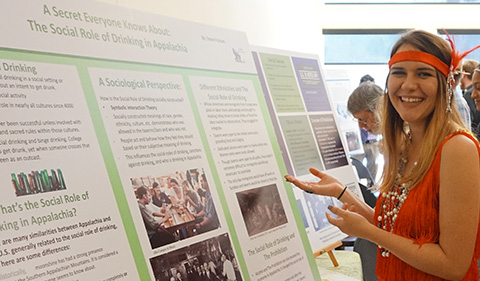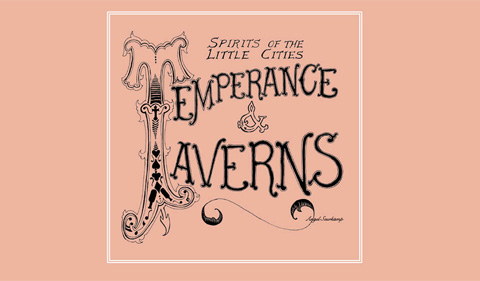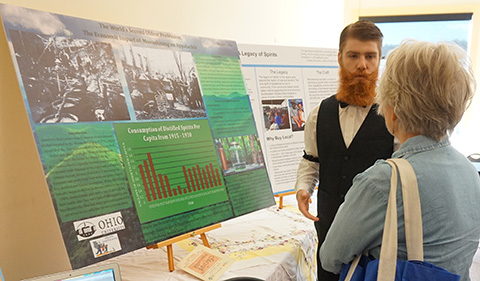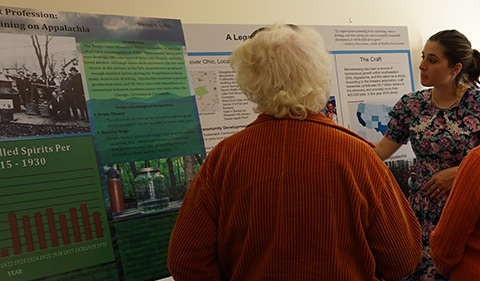
Stevie Putnam in costume at the Spirits of the Little Cities: Temperance & Taverns, the 22nd Annual Little Cities of Black Diamonds Day in October 2016.
Delving into the region’s Appalachian history for a presentation topic, Stevie Putnam ’18 chose to present a poster on the “Social Role of Drinking in Appalachia” as her class participated at the 22nd Annual Little Cities of Black Diamonds Day.
The theme for the event was “Spirits of the Little Cities: Temperance & Taverns”—the history and current state of alcohol consumption & temperance in the coal-mining region in Southeastern Ohio. The day on historic Main Street in Shawnee, Ohio, featured a temperance parade, panel discussions, exhibits, quilt show, pop-up theater, games, live music, and food.
“I talked about what social drinking is, the history in Appalachia involving social drinking, and a present outlook on the role of social drinking in Appalachia,” says Putnam. “This was my favorite aspect of the course, Sociology of Appalachia. We did not have a lot of structure for our poster, so I had to decide what I think should go on the poster, how it was placed, and the message I wanted to get across. This experience will help in future projects, courses, and potential job placements. It helped me polish my researching, communication, and project management skills.”
Other students in Dr. Rachel Terman’s fall Sociology of Appalachia class also presented posters in October at the 22nd Annual Little Cities of Black Diamonds Day, where visitors also had the opportunity to visit the Speakeasy Saloon, which featured local microbrews, moonshine and wine. The event was sponsored annually by the Little Cities of Black Diamonds Council. Support for 2016 included the Ohio Arts Council and the Southern Perry County Academic Endowment Fund.
During the Hocking Valley Coal Boom Era of 1870-1925, there were taverns and drinking rooms in most mining towns throughout this area. Alcohol played a significant role in the lives of miners and others in the Little Cities area, especially during the formation of the mining towns.
Toward the end of the era, the Temperance Movement also had an impact with the adoption in 1920 of the 18th Amendment (later repealed in 1933), which initiated Prohibition.

22nd Annual Little Cities of Black Diamonds Day poster
Terman, Assistant Professor of Sociology, made this annual event a service-learning opportunity for students in her Fall Semester Sociology of Appalachia class. The students’ presentations were supported by the Wealth & Poverty theme.
Service-learning is a form of engaged learning where students make a connection between what they are learning in their course with the experience of addressing a community need. Students will engage in a service project and reflect on their experience as a way of applying course concepts to a context outside of the classroom. In addition to providing a valuable service to the community, students are often able to develop a deeper understanding of the topics they are studying through the service-learning project.
Terman’s use of service learning through community engagement was the topic of Little Cities of Black Diamonds as Classroom, a presentation and panel event during Wealth and Poverty Week in February 2017. Two of her Sociology of Appalachia students participated on the panel.

Wes Gilkey in costume discussing his research with a visitor to Spirits of the Little Cities: Temperance & Taverns, the 22nd Annual Little Cities of Black Diamonds Day in October 2016.
“Our projects were focused on aspects of Appalachian culture, history and society in regards to the topic of Temperance and Taverns. My topic was on the economic impacts of moonshining in Appalachia,” said Wes Gilkey ’17. “There have been multiple periods of time in Appalachia where citizens in the region relied on manufacturing and selling illicit liquors and alcohol, specifically after the Civil War and during the Prohibition. Citizens in SE Ohio not only did their part in manufacturing to make ends meet, but the roads and railroads in the area also served moonshiners with a means to transport bootleg alcohol to major cities like Detroit, Cleveland and Chicago. Farmers in Appalachia found that moonshine was easier to transport over mountains and made more money than crops like corn. Furthermore, when coal mining operations dwindled or stopped, many miners resorted to moonshining as a primary form of income; New Straitsville, one of the Little Cities of Black Diamonds, is a good example of this.
“My experience was very rewarding. There have been very few times during my 5 years at OHIO where I have been given the opportunity to share what I learned in the classroom with the community. Not only did my research further my understanding of the economic climate of Appalachia over the years, but I was able to apply it to a community event and connect other citizens of Appalachia to their history and culture as well. The project was very time consuming, the hands-on work, time spent teaching others, and benefit to the community in Shawnee certainly outweighed any negatives. Taking students outside of the classroom for projects, especially when the projects can benefit the local community as well, is something that I would definitely recommend to any teacher or professor who has the means to do so.
“Skills I used during this project included research skills to find information for my project, Microsoft Office skills to create the poster, writing and design skills to make the posters clear and professional, and communication/people skills while presenting and talking with people attending the festival. To successfully complete the project I needed to utilize all of these skills, and by doing so they were all polished. Keeping myself organized, focused, and “on time” was also paramount to getting the project done on time. Dr. Terman assisted us a great deal and was always available for advice. Even with my personal skills, a great amount of teamwork was needed to really achieve success like we all did. I was really happy with the results, and I think my classmates were as well.”
Student Toshia Edge ’17 , also was in the class, noted, “For my project, I focused on solutions to issues facing Rural America particularly those cities that have been caught up in the boom and bust cycle of coal mining. My focus as an advocate for environmental protection and restoration focused on restoring the natural environment to its former glory and utilizing ecotourism to boost the economy. I believe it is important to start small and local as community members are the most likely agents of social change.
“For me, Little Cities of Black Diamonds Day provided a unique opportunity to apply what we had learned. It is interesting considering for a course such as this you may have a presentation or a final but rarely do you get the opportunity to engage in the community you are studying. I think that brings real value to the course and allows one to immediately see the value added.
“For me, this was the first truly original piece I’ve done while in college. Typically, an assignment has rather rigid guidelines and so long as you follow the formula x+y/z=A you’re set. This was unique in that our only two requirements were that it had to be presented on a poster and it had to be relevant to the event. Otherwise, the project was entirely self-led. At first, it was infuriating. I recall thinking “How am I going to get this done? I don’t even know what is expected of me!” But once it was done, and especially with the passage of time since, I can see that this has given me the confidence to tackle more self-led projects in my own life. Which has resulted in exploring more of my own interests through “special projects.” It doesn’t hurt that I can add this experience to my resume either – bonus!” Edge said.

Toshia Edge discussing her research with visitors at Spirits of the Little Cities: Temperance & Taverns, the 22nd Annual Little Cities of Black Diamonds Day in October 2016.



















Comments